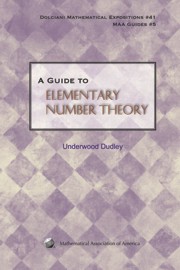Book contents
- Frontmatter
- Introduction
- Contents
- 1 Greatest Common Divisors
- 2 Unique Factorization
- 3 Linear Diophantine Equations
- 4 Congruences
- 5 Linear Congruences
- 6 The Chinese Remainder Theorem
- 7 Fermat's Theorem
- 8 Wilson's Theorem
- 9 The Number of Divisors of an Integer
- 10 The Sum of the Divisors of an Integer
- 11 Amicable Numbers
- 12 Perfect Numbers
- 13 Euler's Theorem and Function
- 14 Primitive Roots and Orders
- 15 Decimals
- 16 Quadratic Congruences
- 17 Gauss's Lemma
- 18 The Quadratic Reciprocity Theorem
- 19 The Jacobi Symbol
- 20 Pythagorean Triangles
- 21 x4 + y4 ≠ z4
- 22 Sums of Two Squares
- 23 Sums of Three Squares
- 24 Sums of Four Squares
- 25 Waring's Problem
- 26 Pell's Equation
- 27 Continued Fractions
- 28 Multigrades
- 29 Carmichael Numbers
- 30 Sophie Germain Primes
- 31 The Group of Multiplicative Functions
- 32 Bounds for π(x)
- 33 The Sum of the Reciprocals of the Primes
- 34 The Riemann Hypothesis
- 35 The Prime Number Theorem
- 36 The abc Conjecture
- 37 Factorization and Testing for Primes
- 38 Algebraic and Transcendental Numbers
- 39 Unsolved Problems
- Index
- About the Author
39 - Unsolved Problems
- Frontmatter
- Introduction
- Contents
- 1 Greatest Common Divisors
- 2 Unique Factorization
- 3 Linear Diophantine Equations
- 4 Congruences
- 5 Linear Congruences
- 6 The Chinese Remainder Theorem
- 7 Fermat's Theorem
- 8 Wilson's Theorem
- 9 The Number of Divisors of an Integer
- 10 The Sum of the Divisors of an Integer
- 11 Amicable Numbers
- 12 Perfect Numbers
- 13 Euler's Theorem and Function
- 14 Primitive Roots and Orders
- 15 Decimals
- 16 Quadratic Congruences
- 17 Gauss's Lemma
- 18 The Quadratic Reciprocity Theorem
- 19 The Jacobi Symbol
- 20 Pythagorean Triangles
- 21 x4 + y4 ≠ z4
- 22 Sums of Two Squares
- 23 Sums of Three Squares
- 24 Sums of Four Squares
- 25 Waring's Problem
- 26 Pell's Equation
- 27 Continued Fractions
- 28 Multigrades
- 29 Carmichael Numbers
- 30 Sophie Germain Primes
- 31 The Group of Multiplicative Functions
- 32 Bounds for π(x)
- 33 The Sum of the Reciprocals of the Primes
- 34 The Riemann Hypothesis
- 35 The Prime Number Theorem
- 36 The abc Conjecture
- 37 Factorization and Testing for Primes
- 38 Algebraic and Transcendental Numbers
- 39 Unsolved Problems
- Index
- About the Author
Summary
Number theory abounds with problems that are easy to state but hard to solve. The Riemann Hypothesis and the abc Conjecture have already been mentioned. There follow some more.
The Goldbach Conjecture, made by Goldbach in 1742, is that every even number greater than 2 is a sum of two primes. This was not a conjecture made for conjecture's sake: Goldbach was trying to help Euler find a proof of the theorem that every integer is a sum of four squares. The conjecture, though undoubtedly true, has turned out to be harder than the foursquares theorem. In 1973 it was shown that every sufficiently large even integer is a sum of a prime and a number that has at most two prime factors.
The primes thin out as we proceed through the integers, but as far out as anyone has looked there are primes p such that p + 2 is also prime. The twin prime conjecture, also undoubtedly true, is that there are infinitely many such pairs. A similar conjecture is that there are infinitely many prime quadruples—p, p + 2, p + 6, p + 8 all prime.
The form of even perfect numbers was determined by Euler. It is not known if any odd perfect numbers exist. If one does, it must be very large, and the conjecture is that there is none. My opinion is that there is one—infinitely many, in fact—but it is too large for us ever to find.
- Type
- Chapter
- Information
- A Guide to Elementary Number Theory , pp. 135 - 136Publisher: Mathematical Association of AmericaPrint publication year: 2009



